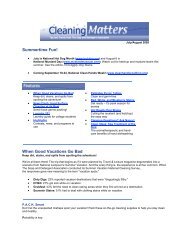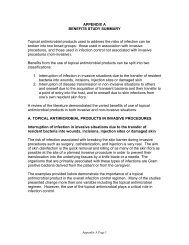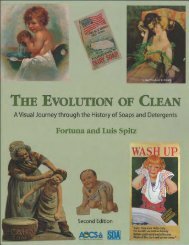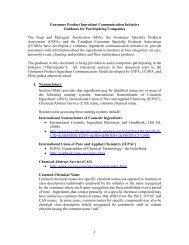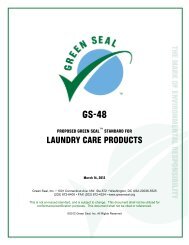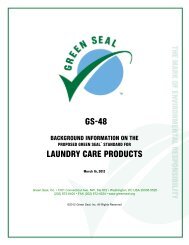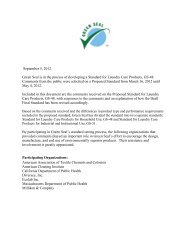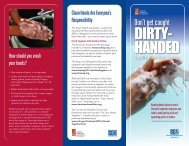subchapter c -- federal hazardous substances act regulations
subchapter c -- federal hazardous substances act regulations
subchapter c -- federal hazardous substances act regulations
You also want an ePaper? Increase the reach of your titles
YUMPU automatically turns print PDFs into web optimized ePapers that Google loves.
conforming to paragraph (b)(8)(i)(E)(1) and<br />
the following wording: “Contains: (list<br />
<strong>hazardous</strong> product(s)) that may be harmful if<br />
misused. Read cautions on individual<br />
containers carefully. Keep out of the reach of<br />
children.”<br />
(10) Statements required under<br />
paragraphs (b)(8)(i) (D) and (E) of this section<br />
must be in the English language and located<br />
prominently in conspicuous and legible type in<br />
contrast by topography, layout, or color with<br />
other printed matter on the label.<br />
(11) Supplemental Information —<br />
Where appropriate, more detailed information<br />
that relates to chronic hazard(s), such as<br />
physical properties, decomposition products,<br />
detailed safety instructions, or disposal<br />
recommendations, shall be included in<br />
supplemental documents, such as Material<br />
Safety Data Sheets, technical brochures,<br />
technical data sheets etc.<br />
(F) chronic Hazard Statements<br />
MAY CAUSE STERILITY.<br />
CONTACT MAY CAUSE PERMANENT<br />
EYE DAMAGE.<br />
MAY BE HARMFUL BY BREATHING<br />
VAPORS/DUSTS.<br />
MAY BE HARMFUL IF SWALLOWED.<br />
MAY BE HARMFUL BY SKIN CONTACT.<br />
MAY PRODUCE BIRTH DEFECTS IN THE<br />
DEVELOPING FETUS.<br />
MAY BE EXCRETED IN HUMAN MILK.<br />
MAY CAUSE HARM TO THE NURSING<br />
INFANT.<br />
CANCER AGENT! EXPOSURE MAY<br />
PRODUCE CANCER.<br />
CANCER AGENT BASED ON TESTS<br />
WITH LABORATORY ANIMALS.<br />
POSSIBLE CANCER AGENT BASED ON<br />
TESTS WITH LABORATORY<br />
ANIMALS.<br />
MAY PRODUCE ALLERGIC REACTION<br />
BY INGESTION/INHALATION/SKIN<br />
CONTACT.<br />
MAY PRODUCE NUMBNESS OR<br />
WEAKNESS IN THE EXTREMITIES.<br />
EXPOSURE MAY CAUSE (SPECIFY THE<br />
ORGAN(S)) DAMAGE.<br />
HEATING/COMBUSTION MAY CAUSE<br />
HAZARDOUS DECOMPOSITION<br />
PRODUCTS.<br />
(G) Precautionary Statements<br />
Keep out of reach of children.<br />
When using do not eat, drink, or smoke.<br />
16 CFR Ch. II (1–1–05 Edition)—proposed modificication – 6/25/06<br />
-- 19 --<br />
Wash hands immediately after use.<br />
Avoid inhalation/ingestion/skin cont<strong>act</strong>.<br />
Avoid fumes from combustion.<br />
Keep container tightly closed when not in use.<br />
Store in well-ventilated area.<br />
Wear protective clothing (specify type).<br />
Wear protective goggles/face shield.<br />
Wear NIOSH-certified mask for<br />
dusts/mists/fumes.<br />
Wear NIOSH-certified respirator with an<br />
appropriate cartridge for (specify).<br />
Wear NIOSH-certified supplied-air respirator.<br />
Use window exhaust fan to remove vapors and<br />
ensure adequate cross ventilation. (Specify<br />
explosion-proof if necessary.)<br />
Do not heat above (specify temperature)<br />
without adequate ventilation.<br />
Use (specify type) local exhausting hood.<br />
Do not use/mix with (specify material).<br />
(ii) The following shall apply with respect<br />
to the standard for art materials set forth in §<br />
1500.14(b)(8)(i).<br />
(A) The term art material or art material<br />
product shall mean any substance marketed or<br />
represented by the producer or repackager as<br />
suitable for use in any phase of the creation of<br />
any work of visual or graphic art of any<br />
medium. The term does not include economic<br />
poisons subject to the Federal Insecticide,<br />
Fungicide, and Rodenticide Act or drugs,<br />
devices, or cosmetics subject to the Federal<br />
Food, Drug, and Cosmetics Act.<br />
(B) The standard referred to in paragraph<br />
(b)(8)(i) of this section applies to art materials<br />
intended for users of any age.<br />
(C) Each producer or repackager of art<br />
materials shall describe in writing the criteria<br />
used to determine whether an art material has<br />
the potential for producing chronic adverse<br />
health effects. Each producer or repackager<br />
shall submit, to the Commission’s Division of<br />
Regulatory Management, Consumer Product<br />
Safety Commission, Washington, DC 20207,<br />
the written description of the criteria described<br />
above and a list of art materials that require<br />
hazard warning labels under this section. Upon<br />
request of the Commission, a producer or<br />
repackager shall submit to the Commission<br />
product formulations.<br />
(D) Notwithstanding any provisions to the<br />
contrary in § 1500.14(b)(8)(i)(E) or §<br />
1500.14(b)(8)(i)(F), all art materials that<br />
require chronic hazard labeling pursuant to<br />
this section must include on the label the<br />
Deleted: All



